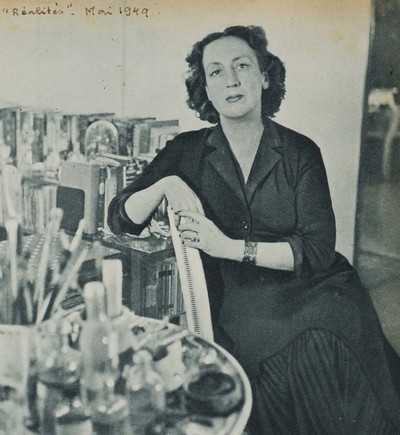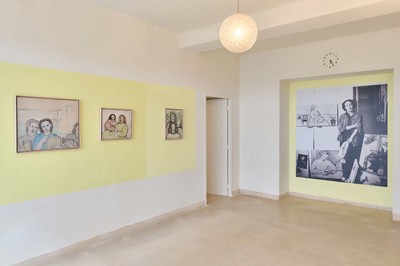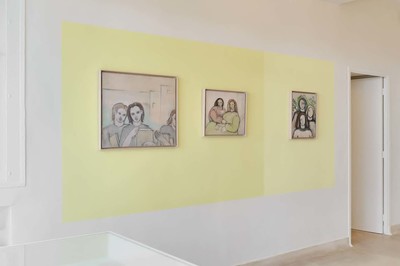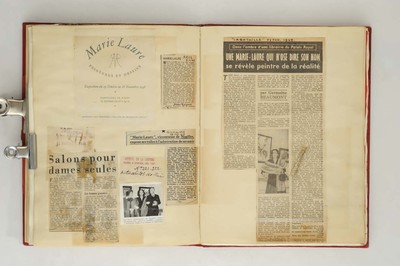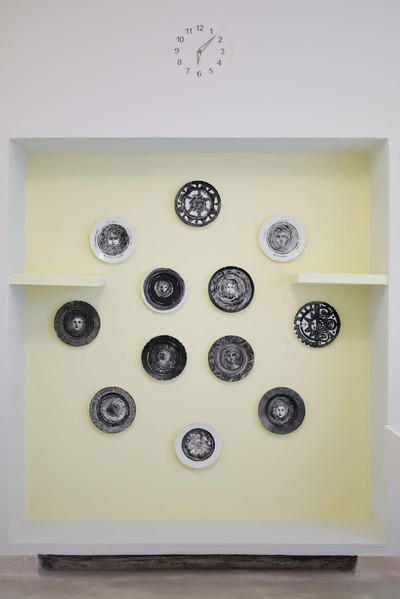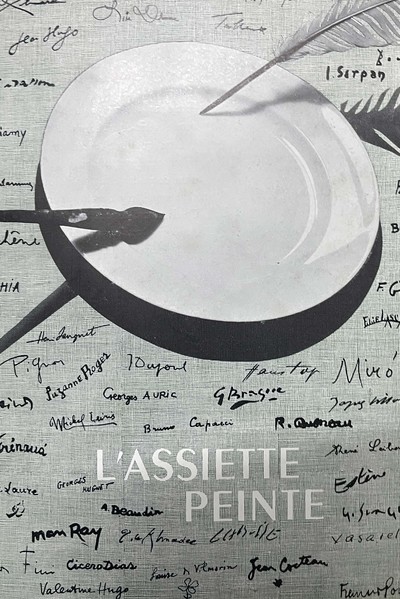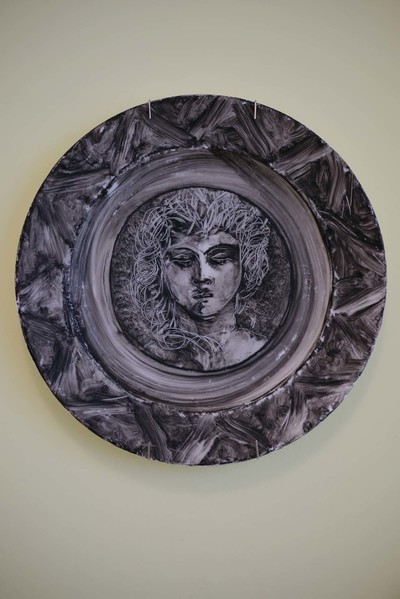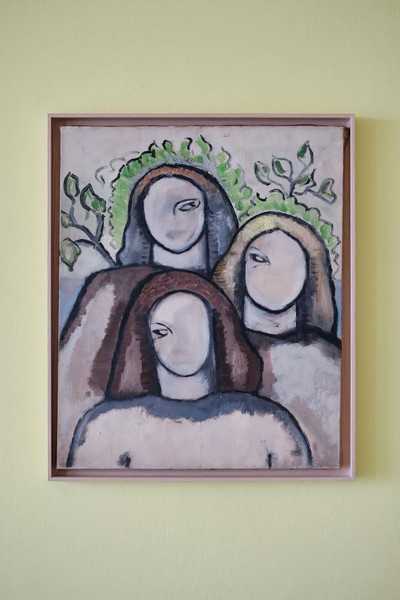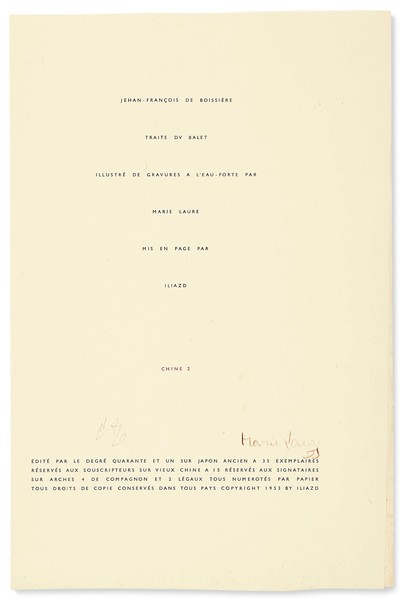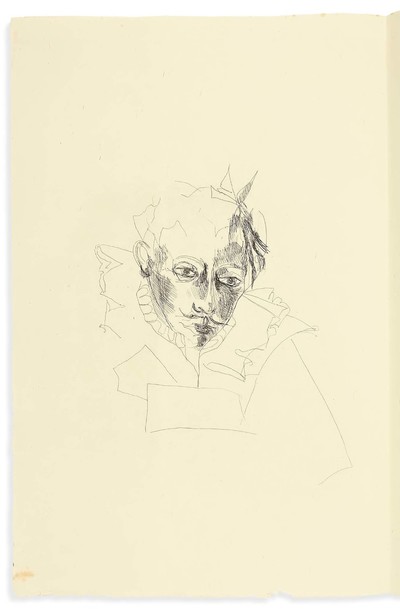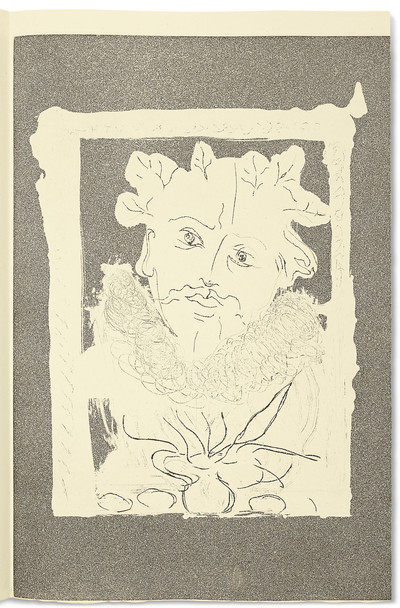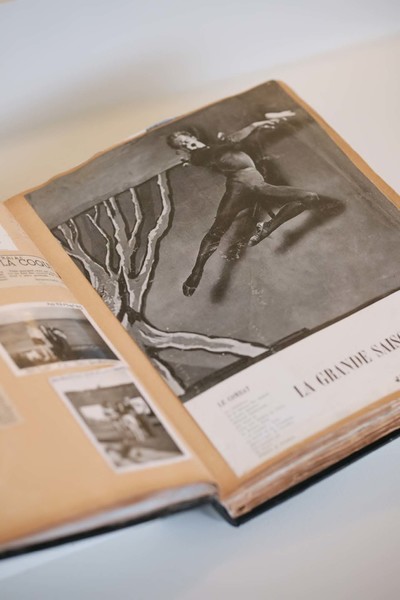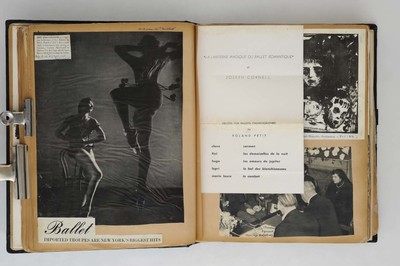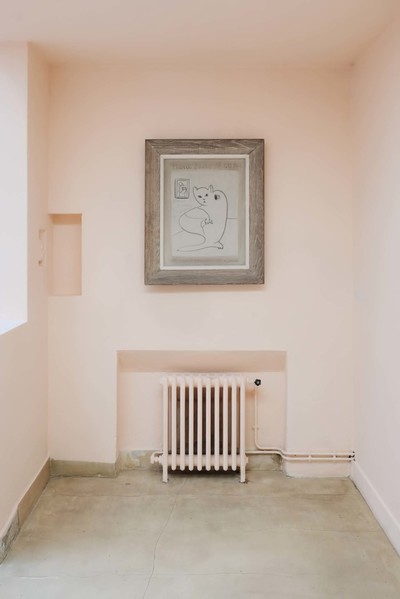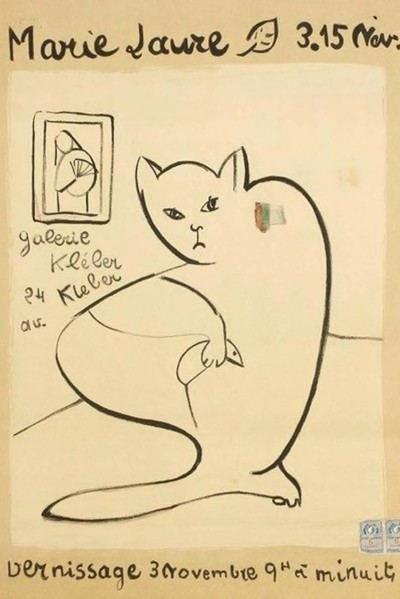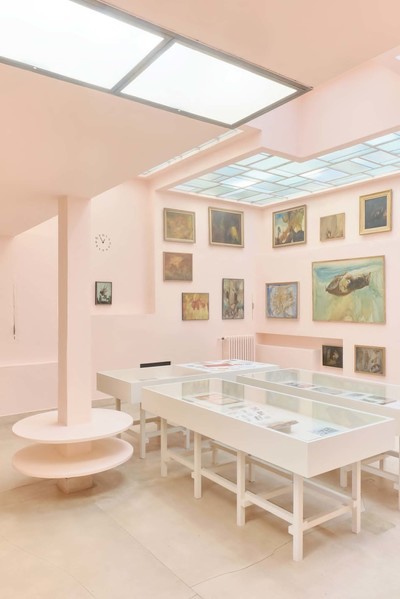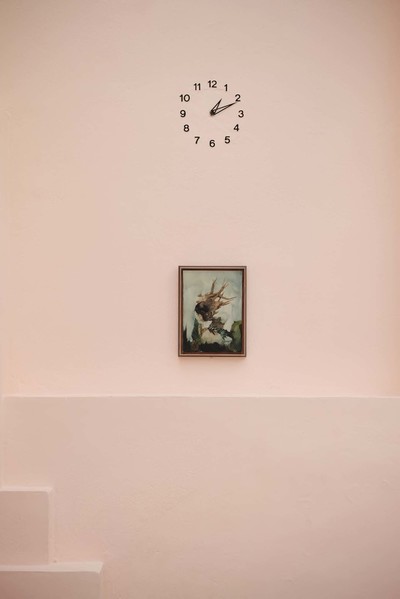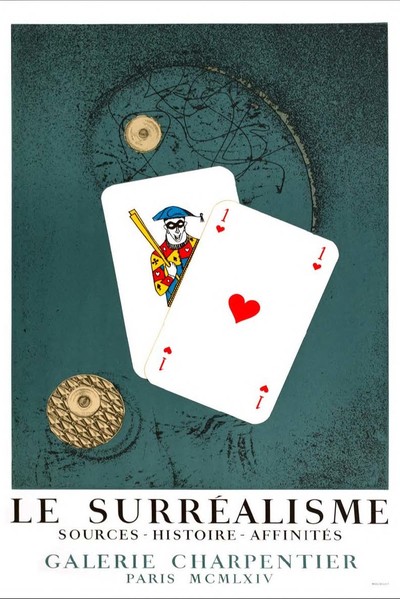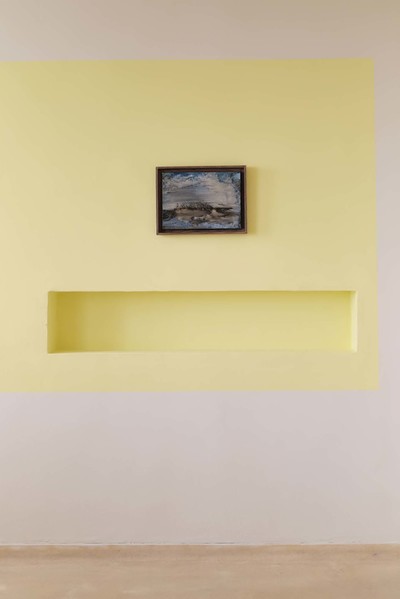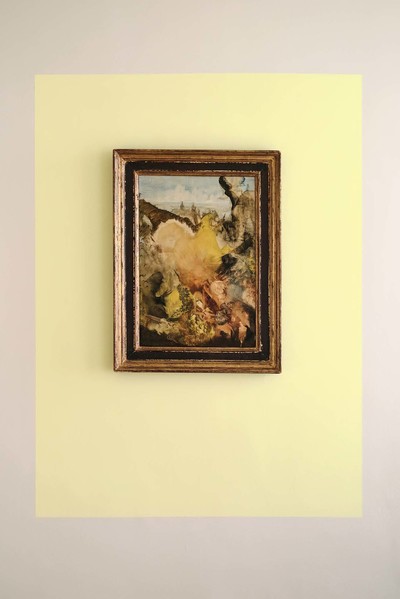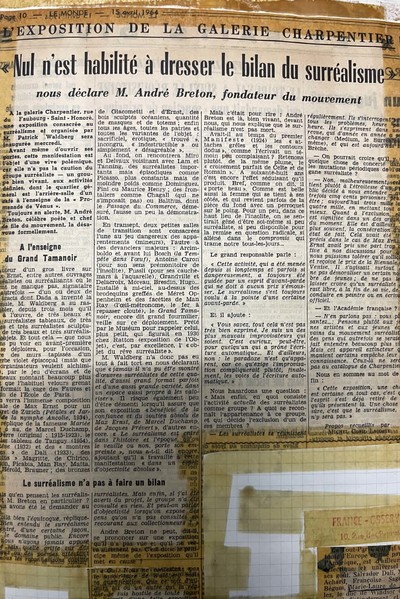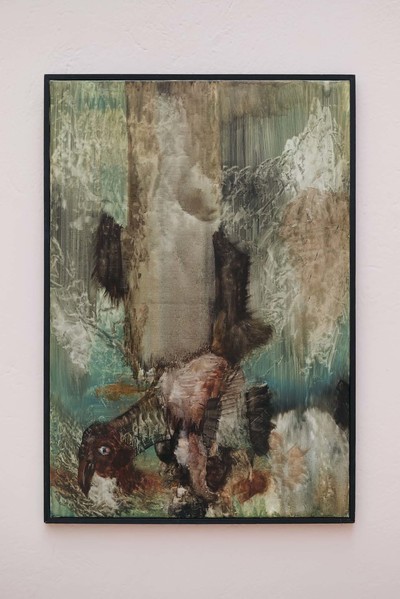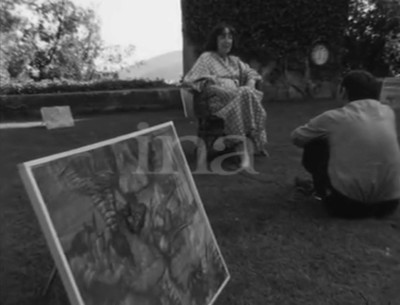Marie-Laure de Noailles peintre
from 9 March to 5 May 2024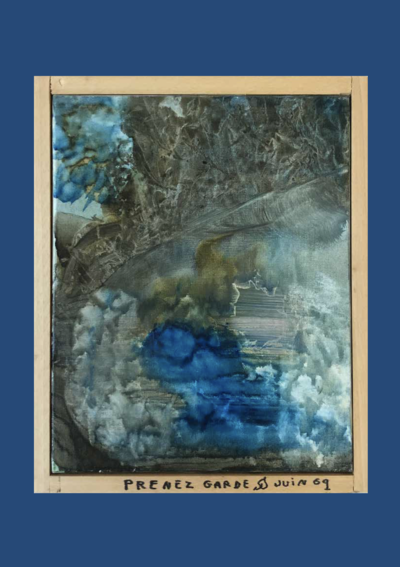
MARIE LAURE DE NOAILLES, PAINTER
from March 9 to May 5, 2024
VILLA NOAILLES,
47 Montée Noailles
83400 Hyères
Exhibition open from Wednesday to Sunday
from 1:00 PM to 6:00 PM.
Closed on Monday, Tuesday, and holidays
Free admission
Guided tours from Wednesday to Sunday at 3:00 PM
no reservations required.
In continuation of the celebrations of the Centenary of villa Noailles and the centenary year of the Surrealist Manifesto, this exhibition aims to explore a lesser-known aspect of Marie‑Laure de Noailles’ life.
Though renowned as a patron, muse, fashion icon, social figure, writer, and poetess, she also identifies herself as an artist.
Photographs taken at Clos Saint-Bernard in Hyères reveal Marie-Laure de Noailles in her studio, where she initially created works inspired by Christian Bérard, an artist friend who also painted her portrait. She developed a body of pictorial work that would later be influenced by surrealism, employing a vocabulary akin to those who would become both her friends and peers, such as Dorothea Tanning, Max Ernst, and Oscar Dominguez. With the latter, with whom she had close ties, she notably explored the surrealist technique of decalcomania.
An eccentric personality, the Viscountess of Noailles defied conventions; she embodied, through her personality as much as her eclectic taste, the avant-garde of the Roaring Twenties.However, the friend of painters did not merely settle for being the irreverent hostess and tasteful patron.
Self‑taught, she, who signed her literary and then pictorial works, since her first novel in 1937 (she wrote eleven published works until 1968) under the name “Marie Laure,” often followed by a stylized tree leaf, embarked on painting in 1946.
At the age of 44, without formal training but rich from a life in continuous contact with artists, nurtured by exchanges with Parisian and European intellectual figures, Marie-Laure de Noailles produced, from 1946 until her death in January 1970, oils on canvas, lithographs, etchings, paintings on stones and plates, ballet sets and costumes, and even sculptures.
Additionally, 24 scrapbooks (albums compiling various original drawings, documents, and mementos), some of which are featured in the exhibition, serve to document these works. This rigorous and organized data collection reflects an artistic ambition characteristic of a painter, rather than the creation of a personal diary.
In 1948, Marie-Laure de Noailles designed the sets for a ballet titled “Le Combat,” by the American William Dollar for Roland Petit’s Ballets de Paris. Then in 1953, Ilia Zdanevitch, known as Iliazd, an editor and poet who worked with Picasso and Miró, commissioned her to illustrate, with sixty-six etchings, the reissued work of Jean-François de Boissière, “Traité du Balet.”
Marie-Laure de Noailles’ work was exhibited in prestigious galleries as early as 1949, notably at the Hugo Gallery in New York, founded in part by Elizabeth Arden and directed by the famous Greek gallerist Alexander Iolas. The latter would subsequently exhibit her works in his own New York gallery. Her creations were also exhibited in Italy at the Galleria del Naviglio and in France at the Galerie du Dragon and the Galerie Kléber (future Galerie Jean Fournier).
In 1964, supported by the critic and writer Patrick Waldberg, she participated in the historic exhibition “Le Surréalisme. Sources‑Histoire‑Affinités,” at the Galerie Charpentier in Paris alongside, notably, Jean Arp, Victor Brauner, Salvador Dalí, René Magritte, André Masson, and Man Ray.
Marie-Laure de Noailles’ works are now preserved in the French collections of the National Fund for Contemporary Art and the Museum of Modern Art of the City of Paris, and have been part of notable private collections such as that of the gallerist and resistant Daniel Cordier.
This exhibition will unfold in two parts: this winter 2024, the presentation of Marie-Laure de Noailles’ work as a painter. This summer, the selection of works from the exhibition “Marie Laure, painter.” will be enriched by “Conversation,” a subjective selection of works by artists from her era, who may or may not have influenced her work. Among them are Dora Maar, Jean Cocteau, Salvador Dalí, Oscar Dominguez, Max Ernst, Georges Hugnet, Léonor Fini, Maurice Henry, Valentine Hugo, Jean Hugo, Jacqueline Lamba, Meret Oppenheim, Felix Labisse, Lucien Coutaud, Marcel Jean, Francis Picabia, Dorothea Tanning, Yves Tanguy, and Toyen.
Johan Fleury de Witte
Solo Exhibitions
1948 Paul Morihien Gallery, Paris, France
1949 Hugo Gallery, New York, United States
1951 Iolas Gallery, New York, United States
1952 Paul Morihien Gallery, Paris, France
1953 Bignou Gallery, Paris, France
1954 Kléber Gallery, Paris, France
1956 Rive Gauche Gallery, Paris, France
1960 Marie Laure, Galerie du Dragon, Paris, France
1962 Marie Laure, Galleria del Naviglio, Milan, Italy
1962 Marie Laure, Galerie du Dragon, Paris, France
1963 Marie Laure 3 × 7 10 F, Galerie de Marignan, Paris, France
1964 Marie Laure, Galerie du Dragon, Paris, France
1965 Georges Barry Gallery, Saint Tropez, France
1966 Desbrière Gallery, Paris, France
1969 Zerbib Gallery, Paris, France
Group Exhibitions
1951 L’Assiette peinte, Christofle Gallery, Paris, France
1952 Modern Painting Exhibition-Sale, La Boétie Gallery, Paris, France
1952 Paul Morihien Gallery, Paris, France
1953 Fantastic Art, Ostend City Museum, Belgium
1953 Les Ballets de Boissière, Bignou Gallery, Paris, France
1953 Demons and Marvels…, Rive Gauche Gallery, Paris, France
1954 Surrealist Paintings, Lima Gallery, Peru
1956–1968 Salon de Mai, Paris, France
1956 Les Oiseaux, Breteau Gallery, Paris, France
1956 Drawings, Connaissance de l’Est Bookstore, Paris, France
1956 Christmas Exhibition, Le Terrain Vague Gallery, Paris, France
1957 Drawings, Gouaches and Watercolors of Poets, Palmes Gallery, Paris, France
1957 Watercolors and Gouaches, Rive Gauche Gallery, Paris, France
1958 Drawing in Magical Art, Rive Droite Gallery, Paris, France
1960 Salon de Mai, Zurich, Kunsthaus, Switzerland
1959–1960 Cour d’Ingres, Paris, France
1960 Giraudeau Gallery, Paris, France
1961 Modern Paintings, Hôtel Drouot, Paris, France
1961 Association of Friends of Fine Arts of Sanary-sur-Mer, France
1962 Unexpected Objects, Museum of Decorative Arts, Paris, France
1963 L’oeil de boeuf, 7 rue de Miromesnil Gallery, Paris, France
1963 H. Legendre Gallery, Paris, France
1964 Surrealism. Sources-History-A!nities, Charpentier Gallery, Paris, France
1967 Portraits, Claude Bernard Gallery, Paris, France
1967 Science Fiction, Museum of Decorative Arts, Paris, France
1968 Hyères Painters Exhibition, Hyères, France
1968 Surrealist Exhibition, Knokke Casino, Belgium
1970 Drawings, Watercolors, Collages, François Petit Gallery, Paris, France
Public Collections (Selection)
National Center for Plastic Arts, Paris, France
Museum of Modern Art of the City of Paris, France
Villa Noailles, Hyères, France
Eduardo Westerdahl Museum, Tenerife, Spain
François Mitterrand Library, Paris, France
Kandinsky Library, Paris, France
The painted plate
Commissioned by the House of
Christofle, the history of this collection
of painted plates began during a dinner
at the legendary restaurant Le Boeuf
sur le Toit.
In the presence of Mr. Tony Bouilhet,
president of the silversmith Christofle,
Jean Cocteau spontaneously sketched
a female face at the bottom of his plate.
Seduced by this sketch, Mr. Bouilhet,
an art enthusiast and friend of artists,
was inspired to launch a collection of
Christofle plates painted by the best
artists of their time. The collection
later expanded to include nearly 100
plates, including works by Marie-Laure
de Noailles, Jean Arp, Georges Auric,
André Beaudin, Georges Braque,
Camille Bryen, Lise Deharme, Paul
Éluard, Maurice Estève, Léonor Fini,
Françoise Gilot, Georges Hugnet,
Jacques de Kermadec, Jean Hugo,
Valentine Hugo, Félix Labisse, Michel
Leiris, Man Ray, André Masson, Joan
Miró, Édouard Pignon, Francis Ponge,
Raymond Queneau, Victor Vasarely,
Jacques Villon…
The plates were exhibited on various
occasions, notably at the Christofle
gallery in 1942 and again in 1951.
“Not being in one’s plate means
discomfort - Put yourself back on your
plate, world of today. Like the hero of
Homer behind his shield, brandishing
his shining spear, keep your buffets,
your beautiful knives, the good laughter
of evening meals. And let the dreaming
children trace mazes in the solitary
parks of green vegetables.”
Marie-Laure de Noailles
Ballets, illustrations,
paintings, lithographs
In 1948, Marie-Laure designed the sets
and costumes for the ballet Le Combat,
choreographed by the American
William Dollar for the Ballets de Paris of
Roland Petit, with music by Raffaello de
Banfield. The premiere of this work took
place at the Théâtre Marigny in Paris in
July 1949.
The ballet was restaged in 1955 for a
performance at the Casino d’Enghien,
featuring renowned dancers such as
Colette Marchand and Jean Babilée.
From 1967, the choreography of
Combat joined the repertoire of the
ballets at the Théâtre des Arts.
Marie Laure started lithography in
1952, under the guidance of Georges
Hugnet at the Desjobert workshop in
the 14th arrondissement of Paris.
Founded in 1923 by Edmond Desjobert,
this workshop welcomed artists such
as Pablo Picasso, André Lhote, Aristide
Maillol, and Marie Laurencin. In this
setting, Marie Laure passionately
created around fifty lithographs
and painted stones for her second
exhibition at the Morihien Bookstore in
Paris, in February 1952.
In 1953, Iliazd (Ilia Zdanevitch), an
editor and poet who collaborated
with artists such as Pablo Picasso
or Joan Miró, entrusted Marie Laure
with the illustration of a reissue of
Jean-François de Boissière’s work,
Traité du Ballet. For this project, she
executed sixty-six etchings.
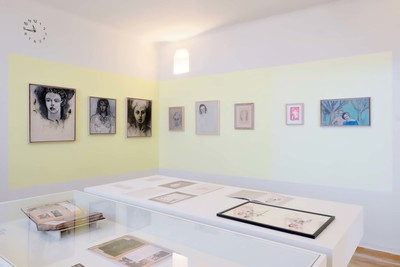
Exhibitions, towards a surrealist style.
Marie Laure’s style evolves as she moves away from
figuration, notably using the surrealist technique of
decalcomania. This method involves spreading a pictorial
substance on a surface, such as canvas or paper, and then
applying another support onto this fresh layer.
After separating the two surfaces, the artist creates a work,
playing notably with pareidolia, a type of illusion that leads
to perceiving a vague or ambiguous stimulus as clear
and distinct. In other words, it’s an instinctive tendency to
find familiar shapes in disordered images, such as stains,
clouds, or constellations.She further refines this technique
alongside Oscar Dominguez, who has been using it since
the mid-1930s and with whom she establishes a close
connection.
She holds numerous exhibitions in various prominent
galleries, including the Galerie Kléber (future Galerie Jean
Fournier) in 1954, the Galerie Rive Gauche in 1956, the
Galerie du Dragon in 1960, 1962, and 1964.
This gallery, directed by Max Clarac-Sérou, showcased the
elite of contemporary art at the time, characterized by its
spiritual dimension, while displaying a pronounced political
consciousness. Among the exhibited artists were illustrious
names such as Balthus, Bellmer, César, Dalí, Giacometti,
Hélion, Hiquily, Ipousteguy, Magritte, Matta, and Aillaud.
“Dear Marie Laure, I loved the breadth and vastness of your
paintings,” Jean Paulhan wrote to her about the paintings
exhibited in December 1962 at the Galerie du Dragon.
“It’s a breadth teeming with dust, elements, and beings. Am
I wrong to prefer Malaria to its neighbors? It’s the one that
bursts forth as if it had just been created, as if the color had
only just been applied. Thank you…”
Marie Laure also had solo exhibitions at the Galleria del
Naviglio in Milan in 1962, the Galerie Marignan in 1963,
the Galerie Desbrières in 1966, and the Galerie Zerbib in
1969 in Paris.
She also participated in group exhibitions (Galerie Rive
Gauche, La Cour d’Ingres, Galerie Palmes, Galerie Rive
Droite) alongside artists who were both her friends
and peers, and whose works she often collected. Dorothea
Tanning, Max Ernst, Man Ray, Nora Auric, Lucien Coutaud,
Félix Labisse, Oscar Dominguez, etc.
“Dear Marie Laure, there will be a crowd at Galerie Marignan,
but the main thing is that you and your painting are loved,
here in Huismes… Countless good wishes, Dorothea and
Max,”
Letter from Max Ernst and Dorothea Tanning to Marie-Laure
de Noailles, 1964. Scrapbook 1963”–”1965.
The French State acquired Le Radeau de la Méduse,
an oil on canvas measuring 88 × 115 cm, at the Salon de
Mai in 1963. This prestigious Salon de Mai, in which she
participated from 1956 to 1968, first as a lithographer and
then as a painter.
Marie-Laure de Noailles,
scrapbook 1951–1955
Collection particulière
Reproductions
In 1954, the Kléber gallery holds a solo exhibition for Marie Laure.
Opening from 9AM to midnight.
The Kléber gallery, initially a bookstore, was where Jean Fournier
was an employee; he would later establish the Jean Fournier gallery,
a historic gallery for artists like Simon Hantaï and Jean Degottex.
Reproduction of the lithographic poster announcing the exhibition at the
Kleber gallery in 1954.
The original artwork used to create the poster is exhibited in this room.
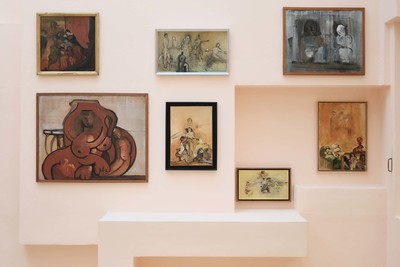
Marie-Laure de Noailles,
scrapbook 1955–1957
Collection particulière
Original
In 1956, Marie Laure participated in the 12th Salon de Mai in the painters’
category. She presented Les ruines végétales, a work that you will find
hanging in this room.
It is noticeable that, since 1954, Marie Laure’s paintings incorporate a
technique similar to decalcomania.
This technique, appreciated by the surrealists, involves, according to the
historian René Passeron, “spreading color (gouache or ink) on a smooth
sheet of paper, applying another sheet on this fresh layer, and then
separating the two surfaces,” allowing her to obtain abstract, undefined,
random shapes with an evanescent appearance.
The relationship she maintained with Oscar Dominguez, a surrealist artist
who invented this technique in 1936, seems to have played a crucial role in
the creativity of both artists, particularly prolific during the 1950s.
They worked together at the Clos Saint-Bernard in Hyères, where they
resided for several months a year and established their studios, creating
a mutual dynamic.
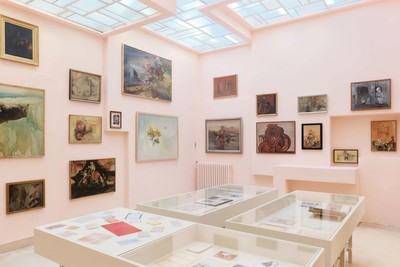
Surrealism.
Sources - History – Affinities
Marie Laure continued to participate
in exhibitions, notably the exhibition,
Surrealism. Sources - History - A!nities
in 1964 at the Galerie Charpentier,
which marked an important milestone
in the institutional recognition and
historicization of surrealism, despite
opposition from some members of the
group to this initiative.
This exhibition, curated by Patrick
Waldberg and Raymond Nacenta,
director of the gallery, was significant
for several reasons. It signified a form
of legitimization of surrealism, making
it accessible to a wider audience.
Approximately 260 works by over 60
artists, including major figures such
as Max Ernst, Joan Miró, and Salvador
Dalí, were exhibited. The exhibition
was divided into three sections:
sources, history, and a!nities, showing
the influences and connections of
surrealism with other movements and
artists. Marie Laure’s work was featured
in the “a!nities” section.
However, this commercial and
historiographical exhibition was
criticized by the surrealists themselves,
who saw it as a distortion of their
movement.
In response, they organized their own
exhibition, L’Écart absolu, at the L’OEil
gallery in December 1965, which
focused on contemporary surrealism
and its subversive potential.
The exhibition at the Galerie Charpentier
in 1964 was a key moment in the history
of surrealism, reflecting the tension
between the commercialization of art
and fidelity to its revolutionary ideals.
It also illustrated the complexity of the
relationship between surrealists and the
institutional and commercial art world.
Marie Laure pursues her practice of
painting until the end of her life.
An exhibition was even scheduled
for February 17, 1970, although she
passed away on January 29, 1970.
At the end of her life, her interest
in avant-garde movements, the
universe of science fiction, and space
exploration remained strong. In May
1968, she was said to have visited the
rebellious students on the barricades,
attended meetings (at the Odéon
theater) dressed in a Chanel suit, and
continued to actively support iconic
artists of the time, especially those from
the Nice school, such as César and Ben.
After briefly opening an art gallery with
César in 1962 in Beaulieu-sur-Mer, their
complicity took an exceptional turn
when she entrusted him with her Zim
car to transform it into a work of art, the
first “compression” by the artist.
In this room, you can discover a work
in tribute to Brian Jones of the Rolling
Stones, who died in 1969.
Proof that the artist has always been
of her time!
“My name is the Viscountess of Noailles…
and then other titles that I have never
worn; therefore, I cannot be a painter,
a writer like others. What a stupid era
ours is! Formerly, a title did not prevent
people from recognizing your talent.
Did anyone discuss the talent of the
Marquise de Sévigné, La Rochefoucauld,
Cardinal de Retz, and Vauvenargues?
Today, a name and a title in the world
of arts is a stigma. I will always be this
absurdity called a ‘woman of the world’.
Jacques Paget, a newspaper article
reporting the words of Marie-Laure de
Noailles in 1970.

